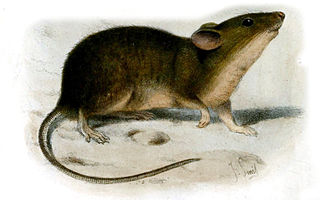
A mouse, plural mice, is a small rodent. Characteristically, mice are known to have a pointed snout, small rounded ears, a body-length scaly tail, and a high breeding rate. The best known mouse species is the common house mouse. Mice are also popular as pets. In some places, certain kinds of field mice are locally common. They are known to invade homes for food and shelter.

The house mouse is a small mammal of the order Rodentia, characteristically having a pointed snout, large rounded ears, and a long and almost hairless tail. It is one of the most abundant species of the genus Mus. Although a wild animal, the house mouse has benefited significantly from associating with human habitation to the point that truly wild populations are significantly less common than the semi-tame populations near human activity.

Mange is a type of skin disease caused by parasitic mites. Because various species of mites also infect plants, birds and reptiles, the term "mange", or colloquially "the mange", suggesting poor condition of the skin and fur due to the infection, is sometimes reserved for pathological mite-infestation of nonhuman mammals. Thus, mange includes mite-associated skin disease in domestic mammals, in livestock, and in wild mammals. Since mites belong to the arachnid subclass Acari, another term for mite infestation is acariasis.

The laboratory mouse or lab mouse is a small mammal of the order Rodentia which is bred and used for scientific research or feeders for certain pets. Laboratory mice are usually of the species Mus musculus. They are the most commonly used mammalian research model and are used for research in genetics, psychology, medicine and other scientific disciplines. Mice belong to the Euarchontoglires clade, which includes humans. This close relationship, the associated high homology with humans, their ease of maintenance and handling, and their high reproduction rate, make mice particularly suitable models for human-oriented research. The laboratory mouse genome has been sequenced and many mouse genes have human homologues.

A fancy mouse is a domesticated form of the house mouse, one of many mouse species, usually kept as a type of pocket pet. Fancy mice have also been specially bred for exhibiting, with shows being held internationally. A pet mouse is inexpensive compared to larger pets, and even many other pet rodents, but mice are comparatively short-lived: typically only 18 to 30 months.

Mus musculus domesticus, the Western European house mouse, is a subspecies of the house mouse. Some laboratory mouse strains, such as C57BL/6, are domesticated from M. m. domesticus.

The genus Mus or typical mice refers to a specific genus of muroid rodents, all typically called mice. However, the term mouse can also be applied to species outside of this genus.

The fauna of the Faroe Islands is characterized by the islands' remote location in the North Atlantic Ocean. There are few terrestrial species, but relatively many breeding seabirds and marine animals. Some subspecies and breeds are endemic. All land mammals were introduced by humans.

The St Kilda house mouse is an extinct subspecies of the house mouse found only on the islands of the St Kilda archipelago of northwest Scotland. They were first described, alongside the St Kilda field mouse, by natural historian Gerald Edwin Hamilton Barrett-Hamilton in 1899.

The steppe mouse or mound-building mouse is a species of rodent in the family Muridae. It is found in grassland and other open areas in Austria, Bosnia and Herzegovina, Bulgaria, Croatia, Czech Republic, Hungary, North Macedonia, Romania, Serbia and Montenegro, Slovakia, Slovenia, and Ukraine.

The Algerian mouse, or western Mediterranean mouse, is a wild species of mouse closely related to the house mouse, native to open habitats around the western Mediterranean.
The ash-grey mouse is a rodent in the family Muridae. Larger and more robust than Mus musculus, the common house mouse, it is found only in Southwest Australia.

The sandy inland mouse is a species of rodent in the family Muridae. Also known as the Hermannsburg (Mission) false-mouse or Hermannsburg Mouse, it is endemic to Australia and found widely yet sparsely through arid and semi-arid areas.

The St Kilda field mouse is a subspecies of the wood mouse that is endemic to the Scottish archipelago of St Kilda, the island 40 miles (64 km) west of Benbecula in the Outer Hebrides, and 100 miles (160 km) from mainland Scotland. Unique to the islands, the mouse is believed to have arrived on the boats of Viking settlers more than a millennium ago. It is not to be confused with the St Kilda house mouse, a subspecies of the house mouse which is now extinct.
Liponyssoides sanguineus is a species of mite that infests the house mouse.
Demodecidae is a family of parasitic mites, living on various species of mammals. Each species of mite is usually only found on a single mammal species, whereas a mammal species can have several different species of demodecid mites living on it. Many species of mites are restricted to very limited areas of their body, e.g. the Meibomian glands, the ear canal, the tongue etc. This family was formerly named Demodicidae.

Mus is a subgenus of the rodent genus Mus.

The mouse brain refers to the brain of Mus musculus. Various brain atlases exist.
The Japanese house mouse or Japanese wild mouse is a type of house mouse that originated in Japan. Genetically, it is a hybrid between the southeastern Asian house mouse and the eastern European house mouse. It is thus not a unique subspecies, but is treated as such for its characteristic features. It is among the smallest house mice. Different strains such as MSM/Ms, JF1, Japanese waltzing mouse, C57BL/6J and MSKR exist following cross breeding with other house mice, and are used in different genetic and medical investigations.













